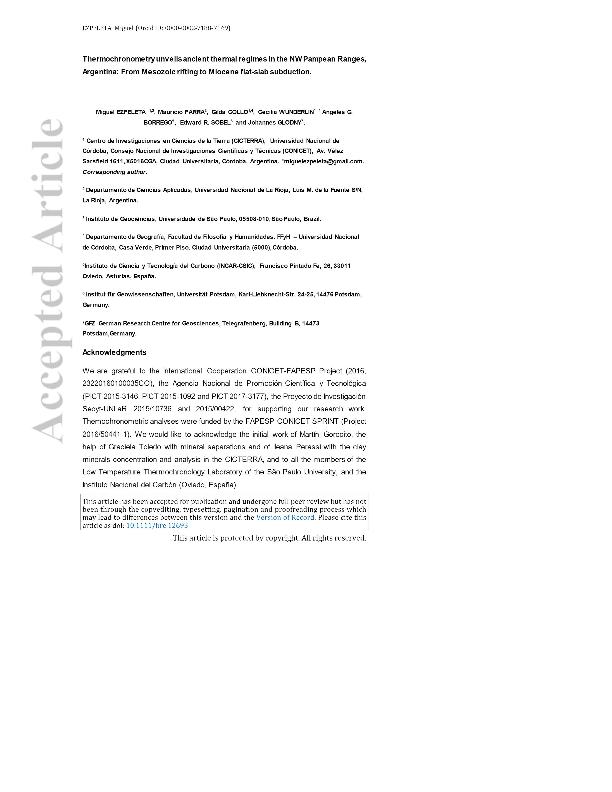Artículo
Thermochronometry unveils ancient thermal regimes in the NW Pampean Ranges, Argentina: From Mesozoic rifting to Miocene flat-slab subduction
Ezpeleta, Miguel ; Parra, Mauricio; Collo, Gilda
; Parra, Mauricio; Collo, Gilda ; Wunderlin, Cecilia Ayelén
; Wunderlin, Cecilia Ayelén ; Borrego, Angeles G.; Sobel, Edward Robert; Glodny, Johannes
; Borrego, Angeles G.; Sobel, Edward Robert; Glodny, Johannes
 ; Parra, Mauricio; Collo, Gilda
; Parra, Mauricio; Collo, Gilda ; Wunderlin, Cecilia Ayelén
; Wunderlin, Cecilia Ayelén ; Borrego, Angeles G.; Sobel, Edward Robert; Glodny, Johannes
; Borrego, Angeles G.; Sobel, Edward Robert; Glodny, Johannes
Fecha de publicación:
12/2022
Editorial:
Wiley Blackwell Publishing, Inc
Revista:
Basin Research
ISSN:
0950-091X
Idioma:
Inglés
Tipo de recurso:
Artículo publicado
Clasificación temática:
Resumen
Reconstructing thermal histories in thrust belts is commonly used to infer the age and rates of thrusting and hence the driving mechanisms of orogenesis. In areas where ancient basins have been incorporated into the orogenic wedge, a quantitative reconstruction of the thermal history helps distinguish among potential mechanisms responsible for heating events. We present such a reconstruction for the Ischigualasto-Villa Unión basin in the western Pampean Ranges of Argentina, where Triassic rifting and late Cretaceous-Cenozoic retroarc foreland basin development has been widely documented, including Miocene flat-slab subduction. We report results of organic and inorganic thermal indicators acquired along three stratigraphic sections, including vitrinite reflectance and X-ray diffractometry in claystones and new thermochronological [(apatite fission-track and apatite and zircon [U-Th]/He)] analyses. Despite up to 5 km-thick Cenozoic overburden and unlike previously thought, the thermal peak in the basin is not due to Cenozoic burial but occurred in the Triassic, associated with a high heat flow of up to 90 mWm−2 and <2 km of burial, which heated the base of the Triassic strata to ~160°C. Following exhumation, attested by the development of an unconformity between the Triassic and Late-Cretaceous–Cenozoic sequences, Cenozoic re-burial increased the temperature to ~110°C at the base of the Triassic section and only ~50°C 7 km upsection, suggesting a dramatic decrease in the thermal gradient. The onset of Cenozoic cooling occurred at ~10−8 Ma, concomitant with sediment accumulation and thus preceding the latest Miocene onset of thrusting that has been independently documented by stratigraphic–cross-cutting relationships. We argue that the onset of cooling is associated with lithospheric refrigeration following establishment of flat-slab subduction, leading to the eastward displacement of the asthenospheric wedge beneath the South American plate. Our study places time and temperature constraints on flat-slab cooling that calls for a careful interpretation of exhumation signals in thrustbelts inferred from thermochronology only.
Archivos asociados
Licencia
Identificadores
Colecciones
Articulos(CICTERRA)
Articulos de CENTRO DE INVEST.EN CS.DE LA TIERRA
Articulos de CENTRO DE INVEST.EN CS.DE LA TIERRA
Citación
Ezpeleta, Miguel; Parra, Mauricio; Collo, Gilda; Wunderlin, Cecilia Ayelén; Borrego, Angeles G.; et al.; Thermochronometry unveils ancient thermal regimes in the NW Pampean Ranges, Argentina: From Mesozoic rifting to Miocene flat-slab subduction; Wiley Blackwell Publishing, Inc; Basin Research; 34; 6; 12-2022; 1983-2012
Compartir
Altmétricas



